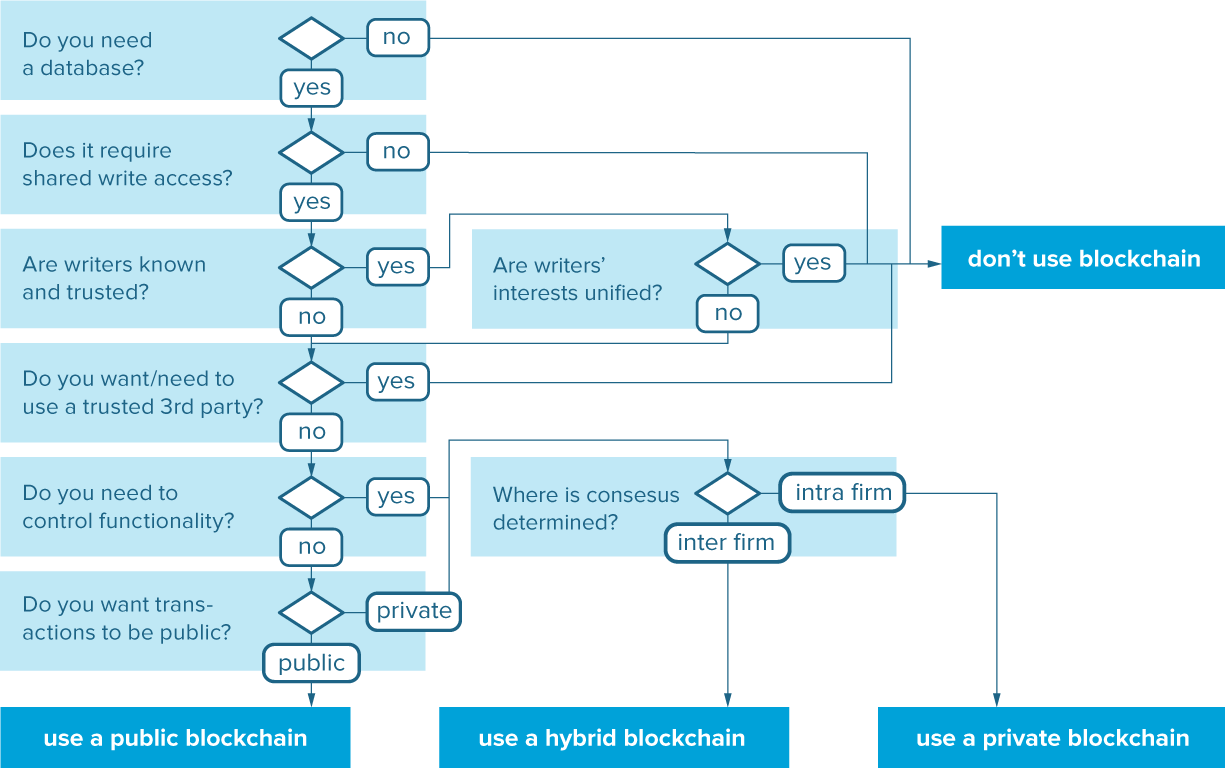Blockchain – What It Is and How It Can Be Used in the Real Estate Sector
Blockchain has been the subject of intense debate for several years now. Judging by what one hears at many conferences, blockchain is rumored to have almost magical potential for disruption.
Some have even gone so far as to say “Get ready to rewrite everything”.1 Others believe that the hype around blockchain technology is overinflated. We explain in simple terms what blockchain is and discuss its significance for the real estate industry.
Blockchain made easy
Many different definitions of blockchain have been published in the trade press and on the internet. Yet it can still be difficult for the non-technical among us to understand how blockchain works. That is because most definitions consist of a succession of technical terms strung together and require a certain level of technical knowledge. So let’s start with the basics. Here is an explanation of blockchain for business managers: Blockchain is the name for a technical database concept which involves storing data that cannot be changed or deleted once it has been verified. Within this database, datasets are attached together in blocks. Subsequent datasets constitute new blocks and are attached to existing blocks. This creates a sequential chain of data blocks.
While this is still a fairly technical definition of blockchain, it becomes easier to visualize if you look at it like an Excel file. Imagine the Excel file as a database. The database consists initially of one worksheet (block 1). The first row in the worksheet is reserved (more on that in a moment). The second row contains a dataset (dataset 1). Another dataset is added in the next row (dataset 2). This is repeated several times until the block has reached a predefined storage limit. In the last row a so-called hash value is generated out of all the datasets. This is a checksum of all of the information stored in the block and is calculated using an algorithm. In each additional worksheet (block 2, block 3, etc.) the hash value from the previous worksheet is entered in the first (reserved) row and included in the calculation of the new hash value.
At this point you can perhaps already see the reason for all the excitement around blockchain. It’s the linking of all the blocks into a chain with a hash value that creates a manipulation-proof database. And it’s easy to see why: If the content of any of the blocks (or any of the rows in our Excel table example) is manipulated, then the hash value of the block will change and the reference figure linking the manipulated block with the next block will no longer match. So the hash value is a proof of integrity that can be permanently validated, which in turn guarantees the integrity of the data. Of course the question is, who is in charge of validating the data? That depends on the type of blockchain being used, in other words what particular attributes the database is meant to fulfill. In a public blockchain anyone can view and validate the data. In our Excel list analogy, this would mean that the database would be distributed between various different computers, so that anyone, anywhere in the world, could see the entries in all cells at any time and check whether their hash values matched. Thus, the public at large would fulfill the control function, as intermediaries have done to date with their databases stored on central servers.
Since a public database is not desirable or appropriate for all scenarios, there are also so-called consortium blockchains and private blockchains. In these cases the access to data is restricted to a certain number of participants (within a consortium or within a company) and only selected members can validate datasets.
So as you can see, there is no such thing as ‘the’ blockchain. What blockchain is, in fact, is a way of processing and storing data. For every different application you therefore need to check in advance whether blockchain makes sense in your particular scenario and which type of blockchain is the right one for you.
Blockchain vs. Bitcoin
No doubt you have already heard of the cryptocurrency called Bitcoin. Bitcoin is the best known use case for blockchain technology, but it is by no means the only one. Bitcoin is often wrongly considered synonymous with blockchain. In fact, Bitcoin as a cryptocurrency builds on a special type of blockchain without which it could not function. It is helpful to take a look at the Bitcoin blockchain to understand the benefits and potential uses of blockchain. Bitcoin is a network consisting of a virtual payment system and a virtual monetary unit. Unlike conventional currencies, transactions within a Bitcoin network are processed without intermediaries (like banks). Everything is done peer-to-peer instead.2 This is possible because the trust function fulfilled by the intermediary is replaced by the collective because it is the collective that validates the transactions. In fact, the transactions are validated by so-called miners. In the Bitcoin network, any participant can act as a miner and be involved in validating the transactions. There is a financial incentive to do so, in that only the first miner to correctly validate the transaction receives a payment in the form of Bitcoins.
The disruptive nature of blockchain technology consists in the fact that it cuts out all intermediaries. For the first time it is possible for a technology as opposed to a legal entity to generate the trust necessary for the exchange of items of value. Cutting out the intermediary in this way facilitates the transformation from an internet of data to an internet of values. And because the blocks (Excel worksheets) can record the transfer of any conceivable form of value, it is not only financial intermediaries like banks but all intermediaries of any kind that can be cut out by the blockchain technology.
Use cases
There are many different potential uses for blockchain. The main industry that is currently testing blockchain technology is the financial sector, where the potential efficiency gains are greatest. Banks spend 65–80 billion dollars every single year on clearing and settlement. All this money could be saved in the future. The technology also enables smart payment methods such as refrigerators, which could automatically order produce and pay for it upon delivery.
The energy sector is also applying blockchain. RWE, for example, is working on an electrical outlet adapter for electric vehicles. The adapter can be plugged into any power outlet and then connected to a vehicle. It’s not the owner of the electrical outlet that is billed for the power consumption, but the owner of the vehicle. What the blockchain does is note how much energy is consumed in charging the vehicle.
No industry will get by without blockchain in the supply chain management scenario of the future. That is because the use of blockchain will enable everything from the raw material to the finished product to its ultimate recycling to be documented and monitored from start to finish with no gaps. Smart sensors may be used to do this. Products like meat, for example, can be shipped in containers, whereby if there was any break in the cool chain the sensors would pick up on this and payments would not be released.
People are also talking about smart contracts in this context. These are computer programs that represent contracts and automate the contract handling process. To enable this to happen, contract compliance is monitored in real time and the rights of the contractual parties are asserted automatically. Leasing agreements are one example of where smart contracts can be used: if a customer does not pay the monthly installment for their car, access to the vehicle can be automatically blocked.
Blockchain in the real estate industry
The question is whether blockchain technology also makes sense for use in the real estate industry. Indeed it does: for example rental contracts could be automated as in the leasing example above, whereby the apartment door would remained locked if the tenant failed to pay the rent. Unfortunately the legal framework does not allow for this at the present time.
Another scenario that is already possible today concerns the automation of maintenance and claims management. Detecting damp in the walls, spotting mold and mildew, reporting defects by the tenant, getting the painters in, accepting, paying and even proving insurance and warranty claims are all procedures that can be automated. Things like this that might involve numerous interfaces today will be completely automated in the future with smart wall sensors. R&D departments are currently working on developing such sensors that may well help to significantly automate cost-intensive processes. The way it would work is as follows: the sensor would be installed in or on the wall and permanently measure the condition of the walls as well as the temperature and humidity in the property. This data would then be stored in the blockchain. If there was a brief spike in the humidity level inside the apartment, the tenants could be contacted by smart phone and asked to air the property, or a window could be opened automatically. If the level stayed high for a lengthy period, this would trigger a home visit. In the event of water damage, the water valve would be closed and a call placed with the emergency services. Any successful repair activity would be noted in the block chain. With a smart contract in place, the payment to the service provider would be triggered automatically. And the insurance company, again with a smart contract in place, would be able to trigger the payout to their customer because the data from the sensor would provide proof that water damage had occurred. So what this does is turn concrete into a smart material that supplies the landlord with valuable information. It’s not uncommon for there to be a disagreement with tenants about humidity levels, mold and mildew and fluctuating temperatures in a property. The use of smart sensors can help more quickly to identify and, crucially, to prove what caused it.
Currently, many companies are also considering how entire real estate transactions can be handled through the blockchain or certain process steps (cutting out various intermediaries) can be optimized with its help. Notable firms include chromaway.com, rexmls.com and ubitquity.io. If these projects prove successful, this would be another major step toward the enhancement of existing platform solutions. The Australian platform pexa.com.au, for example, already facilitates the transfer of real estate on an almost completely paperless basis. It is, however, highly restricted, with only licensed intermediaries such as lawyers, notaries public and financial institutions having access to the system. True disruption of the real estate transfer process will not be achieved in this way, unlike with blockchain technology.
Blockchain in your company
So, if you are now playing with the idea of using blockchain technology in your company, we have put together a few important things to note. Of course we cannot possibly say for sure whether or not blockchain is right within the real estate industry context – and whether or not you should use blockchain in your company depends on the specific scenarios for which you wish to use it. Do you need a database? Is it sufficient for you to have control over the data? Are you going to be making payments with it? These are just some of the questions that need to be answered before you start planning the implementation of new technical solutions. But once you’ve done that, the use of blockchain can add significant value. It may be helpful to adopt a visionary perspective: Few companies today have a detailed record of all the components used to construct the buildings in their portfolio. But that is going to change, partly as a result of the increased promotion of BIM by policymakers. So why not think about future-proof solutions right away? The illustration below can help you as part of a dedicated analysis to identify whether using blockchain could be advantageous to you generally speaking, and what type of blockchain – public, hybrid or private – would suit you best.

Fig. 1: Do you even need Blockchain? by Bart Suichies, December 2015
Going back to our example with the wall sensors, this would mean deciding whether the smart wall should communicate only with the caretaker (for standard cases) or the company’s own engineer (for more complex measures) when it identifies a need for communication. If so, a private, company-internal blockchain can be used, which may involve putting in place a reliable ticketing system and linking it up to smart objects.3
If, on the other hand, you wanted to exploit the full extent of the possibilities available with a smart wall, it would need at the very least to be integrated into a hybrid blockchain (consortium blockchain) to which tradesmen and insurance companies were also connected. This would be the only way to enable automated communication with them.
And if you wanted to create a platform with the potential for its applications to grow and with no restrictions on the types of people who could participate in it, or even with the ability for the public to act as the control body, ensuring that none of the parties involved ever had a monopoly in the blockchain, then a public blockchain would be the right way to go.
Summary & outlook
Blockchain could very well be a game changer in the real estate sector. Buying and selling properties, utility billing, renting – in almost every area there is the potential for blockchain to be used. Currently, however, it remains mostly a mental exercise. The crucial thing will be whether meaningful use cases can be identified that are actually possible from a legal perspective. That said, the real estate sector needs to get creative and think proactively about possible application scenarios. Policymakers have long been thinking about blockchain, considering what underlying framework they need to put in place to enable it to be used in any meaningful way. Ideas range from giving each individual a blockchain private key stored on their ID card to giving robots and artificial intelligence legal personality so that they can act autonomously. Whatever happens, blockchain is a subject that the real estate sector will certainly need to address.
Contact
Do you have questions regarding this topic? Please contact:
-
 Dr. Mathias Hain
Dr. Mathias Hain-
email hidden; JavaScript is required
-
email hidden; JavaScript is required
1http://startupmanagement.org/2...
2 Ownership of the monetary unit is proved by the ownership of cryptographic keys. That is why Bitcoin is known as a “cryptocurrency”.
